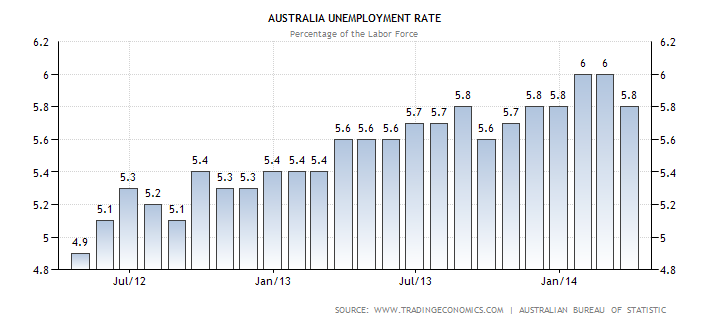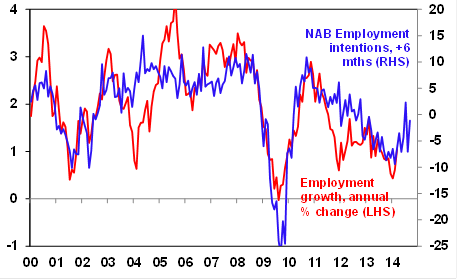Never mind the small, but significant point that the March jobs data from the ABS yesterday, and the surprise fall in unemployment contained in it, send conflicting stories about the health of the labour market and the wider economy.
Yes, it was good news with the jobless rate surprising everyone with a fall to 5.8% (from 6.1% in February) as more new jobs were created.
But there was a lot of noise in the numbers for a second month, leaving quite a few analysts confused.
But so far as the currency markets were concerned the ‘noise’ and those confusing signals from the jobs report for March (and from the equally odd one for February) were for others to sort out.
They saw only one outcome – that golden oldie of headlines ‘rate rise looms’.
So, after the report was released at 11.30 am yesterday, the dollar jumped and peaked at 94.44 – yet another high for this year and up more than half a cent in a matter of minutes.
It then eased back to around 94c as the apparently weak Chinese trade data for March emerged and then recovered to 94.16c in Asian trading this morning.
The headline in the figures was based on the dip in the unemployment rate to 5.8% – so far as the punters in the forex market were concerned, interest rates here will be jacked up by the Reserve Bank, sooner than later.
From various statements, reports and speeches, the RBA is prepared to accept a rise in inflation, so far as it is accompanied by stronger growth and employment.
The bank is in a wait and see mode until it tells us otherwise.
Of course so far as the markets are concerned, if the higher dollar starts choking the economy – as it did from 2011 through to 2013, and clipping exports and creating pain for manufacturing and some service companies, that’s a complication, but not a reason to leave rates where they are.
But a rate rise is the last thing on the minds of the Reserve Bank. It wants to watch the jobs market for a while yet, as well as housing, retailing and a host of other sectors.
Seasonally adjusted the number of new jobs rose 18,100 in March, after a rise of 47,300 in February.
But after the big jump in full time jobs in February, reported as more than 80,000 (seasonally adjusted), the number of full time jobs fell in March by more than 22,000.
At the same time the number of part time jobs rose more than 40,000 after they fell more than 33,000 in February.
The unemployment rate dipped to 5.8% from 6% (and close to 6.1% on unrounded figures).
Confusing matters even more, the number of hours worked in March rose by an estimated 8 million, after falling 14 million in February.
And the participation rate fell 0.2% to 64.8%, after rising 0.2% in the revised February report.
Message in the jobs data, and its not ‘rate rise looms’

So let’s look at what the first quarter of 2013 has told us about the jobs market.
In the three months to March, the economy added 88,000 new jobs seasonally adjusted, and 42,800 in trend terms, compared to 60,000 jobs seasonally adjusted for the whole of 2013 and 75,000 in trend terms; since December the overall unemployment rate has fallen from 5.9% to 5.8% seasonally adjusted, while the participation rate has increased marginally in seasonally-adjusted terms and remained steady in trend terms, while aggregate hours worked has increased 1% seasonally adjusted, whereas aggregate hours only increase a fifth of one per cent over the whole of 2013.
That all suggests that, beyond the monthly seasonally adjusted volatility, the labor market is performing significantly better than in 2013 and that the fall in the participation rate that has marked recent years seems for the moment to have halted.
And the hint that the labour market is turning seems to be supported by the ANZ job ads survey, which showed a revised no change in January (from an originally reported small loss) to a big rise of 4.7% in February and a 1% rise in March, for positive first quarter growth. Certainly the graphs that come with the ABS report suggest there could be a turning point for the labour market in the offing.
But that’s still tentative and there continue to be clear signs of weakness in the labour market.
And if you look at other indicators, there’s a lot more good news. Retail sales are solid and growing nicely, building approvals are still growing and home lending is booming – up 2.3% in February alone.
It all suggests that official forecasts of economic gloom and doom (and lower tax revenue because of it) might not be the case, and that the economy is gathering itself for higher growth in coming months.
The only threat in all this is the dollar, which already had upward momentum before this jobs report.
In a note yesterday, the AMP’s Dr Shane Oliver said, “the details in the report were a bit messy with full time jobs down 22,000, although after an 80,000 gain in February this was to be expected, a fall in the participation rate largely explaining the fall in unemployment and an odd slump in unemployment in WA from 5.9% to 4.9%.
"Given the messy details along with the monthly volatility in the jobs figures and the tendency for them to go through hot and cold periods it’s probably best to focus on the trend and it is showing monthly jobs growth of around 14,000 and unemployment rising only very slowly.
"Overall our assessment is that the Australian jobs market is not quite as strong as the last two months’ data suggests but it’s much better than all the headlines about job layoffs imply. Importantly most forward looking employment indicators are now rising including those for job vacancies and job ads and hiring intentions as indicated by the NAB Business Survey (see chart below).
NAB survey points to improving employment growth

Source: ABS, NAB, AMP Capital
"Taken together this suggests that the jobs market is gradually improving and that there is some chance that we may have already seen the peak in unemployment. This is all consistent with a gradual improvement in economic growth this year in Australia. We see no reason to change our expectation for a rate hike in September/October, with the risk of another rate cut now almost zero," he wrote.













